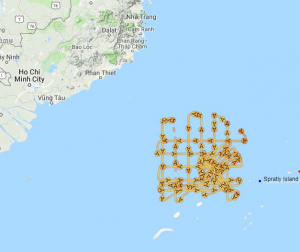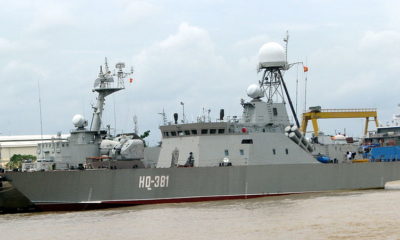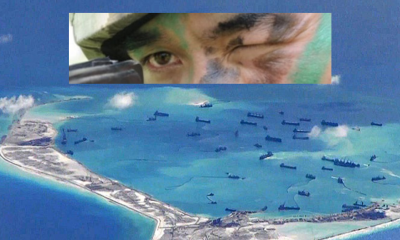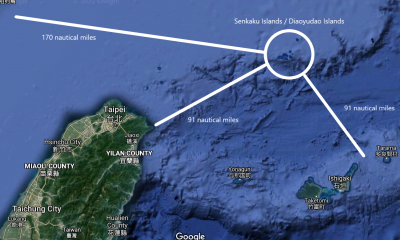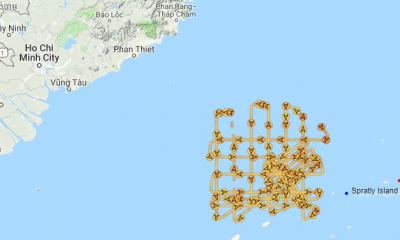Nguyen Luong Hai Khoi
China’s Campaign to intrude into the Continental Shelf and EEZs of Southeast Asian Countries in 2019 (Part 1: Process of the campaign, Part 2: Military tactics of the campaign, Part 3: Legal Aspects of the campaign)
From July to October 2019, China launched a campaign to intrude into the continental shelf and exclusive economic zones of many countries in the South China Sea, East China Sea, and Pacific.
At that time, each country’s media focused almost exclusively on China’s intrusion into its own exclusive economic zone and less so on China’s behavior regarding other countries. As a result, most countries saw only a portion of China’s behavior without seeing the extensive campaign as a whole.
By aggregating data on China’s behavior at sea in 2019, we have uncovered a large-scale, well-conducted campaign organized at the level of China’s top leadership.
The campaign to intrude into the territorial sea, continental shelf, and exclusive economic zones of Southeast Asian countries in 2019 marked many turning points for China. China’s artificial islands in the Spratlys have demonstrated the capabilities and logistical role of long-term operations in the South China Sea. The China Coast Guard has become the armed forces and is under the Chinese Central Military Commission’s direct control. It is a significant threat to the small countries of Southeast Asia. The next question to ask is what this campaign foreshadowed in China’s foreign policy in the South China Sea.
Reconnoiter Before the Campaign
China’s campaign to intrude into the continental shelf and the exclusive economic zones of Southeast Asian countries in 2019 lasted more than three months, from early July to early October. Before this campaign, China had reconnoitered countries in South East Asia.
In 2018, China only patrolled in the territorial waters and exclusive economic zones of Malaysia, the Philippines, and Vietnam. In 2019, China continued patrolling, escalated the level of aggression, and organized a campaign to survey the continental shelf areas as well as disrupt the oil and gas exploitation of these countries.
The campaign ran from July to October, but the first signs appeared in March 2019. It was then that Indonesia captured an underwater drone spying on the Riau islands. Indonesia identified this underwater drone as belonging to China.
In May 2019, Collin Koh, Research Fellow at the S. Rajaratnam School of International Studies, based in Nanyang Technological University, Singapore, made an announcement on Twitter about China’s intrusion into Malaysia’s exclusive economic zone. Koh stated in detail that “in late May, a Chinese Coast Guard patrol vessel 35111 prevented the “Sapura Esperanza” platform from drilling near the South Luconia Shoals, located just over 160 km from the Malay coast.” (See also AMTI: China risks flare-up over Malaysian, Vietnamese gas resources).
From May 10 to 27, 2019, the China Coast Guard ship Haijing 35111 repeatedly patrolled the Luconia Breakers rocky area. The Luconia Breakers are above sea level at low tide, so it has 12 nautical miles of the territorial sea.
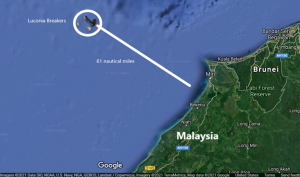
The position of Luconia Breakers administrated by Malaysia (Photo: Google map. Information noted by the author)
In June 2019, four Chinese J-10 fighter jets landed on Wood Island in the South China Sea. They did not park inside the hangers but instead parked for many days on the runway. With this aggressive act, China intentionally attracted the attention of other countries. (See CNN: South China Sea: Satellite image shows Chinese fighter jets deployed to contested island, June 21, 2019)
On June 9, a Chinese vessel sank a Philippine fishing boat and left without saving the fishermen. The Filipino fishermen were saved by Vietnamese fishing vessels. China later claimed that the Chinese ship sank the Philippine boat because it felt threatened by it. From June 29 to July 3, China organized live-fire exercises in two South China Sea areas. The first was in the middle of the South China Sea, outside the EEZ of Vietnam and the Philippines. The second was inside China’s EEZ and part of Phu Lam Island’s sea territory in the Paracel Islands where China has invaded South Vietnam since 1956. China shot six anti-ship missiles during these exercises. Admiral Philip Davidson, commander of US forces in the Pacific and the Indian Ocean regions, called this behavior a threat to the United States. (See CNN: “China tests anti-ship missile in South China Sea, Pentagon says,” July 3, 2019).
China’s Campaign to Intrude into Vietnam’s Continental Shelf and EEZ
On July 3, 2019, China’s Haiyang Dizhi Bahao (HYDZ-8) survey vessel entered Vietnam’s territorial sea, exclusive economic zone, and continental shelf. The HYDZ-8 survey vessel conducted a three-month continuous survey of Vietnam’s continental shelf from the beginning of July to October. This intrusion was the second most serious campaign to survey Vietnam’s continental shelf, after Hai Yang Shi You 981 deepwater rig platform campaign to intrude on and survey Vietnam’s continental shelf in May 2014. From July 3 to August 1, 2019, the Haiyang Dizhi Bahao (HYDZ-8) geological survey vessel entered the waters close to Vanguard Bank (Vietnamese: bãi Tư Chính, Chinese: Wànān tān) and Rifleman Bank (Vietnamese: Vũng Mây, Chinese: Nanwei tan). Three China Coast Guard ships followed to protect HYDZ-8.
While HYDZ-8 was entering and surveying the Vietnamese continental shelf north of Vanguard Bank, Ryan Martinson, professor at US Naval War College, discovered that China Coast Guard’s ship 35111 had been deployed “about 40 nautical miles west of Vanguard Bank since June 18.” This cutter was armed with a 76 mm cannon.
On July 12, 2019, ship 35111 backed to Fiery Cross Reef and then returned to the Vanguard Bank area. This vessel was not directly involved in the HYDZ-8 activities but carried out provocative and aggressive acts around the Hakuryu-5 rig, on block 06-01 of the Nam Con Son Project, a joint venture project of Vietnam with Russia.
China’s Combined Arms Campaign to Intrude into Vietnam’s Continental Shelf and EEZ
In early August 2019, HYDZ-8 returned to base at Fiery Cross Reef. On August 13, HYDZ-8 was present at the coordinates 9.32333 ° N, 111.7217 ° E, exactly where it had previously surveyed. The two China Coast Guard ships 31302 and 33111, which had previously operated only in the East China Sea, appeared off the coast of Vietnam’s Quang Tri province. They were moving to the south. These two ships had never been on a mission in the South China Sea before.

Two China Coast Guard ships, 31302 and 33111, which had previously operated only in the East China Sea, were on the way to the Vanguard Bank in the South China Sea on August 13, 2019. (Source: Marine Traffic/ Ryan Martinson)
At this point, China deployed many different pieces concurrently on the chessboard of the South China Sea.
On August 13, a few days after HYDZ-8 returned to survey Vietnam’s continental shelf and EEZ, China simultaneously dispatched forces to intrude into and investigate the EEZs of Malaysia and the Philippines. According to data from Marine Traffic / Ryan Martinson, the Chinese vessel that surveyed Malaysia’s EEZ was the Shi Yan 2 and the ships that surveyed the Philippines’s EEZ were the Dong Fang Hong 3 and the Zhang Jian. China’s survey ship Haiyang 4 had also been operating in Malaysia’s EEZ up until August 20. In addition, China dispatched the Haiyang Lu Hao (HYDZ – 6) survey vessel to investigate further out in the Pacific near the Hawaiian Islands.
On August 15, China dispatched Haiyang Si Hao (HYDZ – 4) and many other Coast Guard ships that had previously operated in the East China Sea to the South China Sea in order to intrude into and survey Malaysia and Vietnam’s EEZs.
According to the Japan Coast Guard’s data, from January to August 2019, China maintained 12 consecutive intrusions into the 12-nautical mile territorial waters of Senkaku Island (increased to 14 times in May and decreased to 8 times in June). In September 2019, when several ships previously only in charge of the East China Sea were deployed to the South China Sea, the number of intrusions into Senkaku Islands’ territorial waters fell to half.
On August 15, the survey vessel HYDZ-8 moved south, to a location 90 nautical miles from Vanguard Bank.

Operation of the HYDZ-8 from August 13 to 16, 2019 (Data from Marine Traffic / Ryan Martinson)
Simultaneously, China deployed five survey vessels to intrude into Malaysia’s continental shelf and exclusive economic zone.
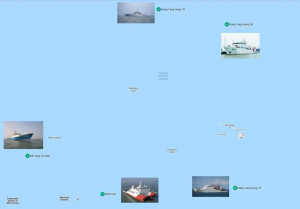
China deployed many survey vessels, Hai Yang Liu Hao (IMO: 9549126), Xiang Yang Hong 09 (IMO: 8425074, MMSI: 412917000), Xiang Yang Hong 06 (IMO: 8875011), Xiang Yang Hong 10 ( IMO: 9696199), Shen Kuo (IMO: 9841639, MMSI: 413381130) to intrude into Malaysia’s continental shelf area and exclusive economic zone. (Source: Marine Traffic/ South China Sea Chronicle Initiative)
At the end of August, HYDZ-8 focused on surveying the area that China called RJ 27 block and a part of WAB-21 block. These oil and gas exploitation areas are in Vietnam’s continental shelf and EEZ. PetroVietnam calls RJ27 block “block 155” and “block 156,” It calls WAB-21 block “block 132” and “block 133.” The upper corner of block 155 (Vietnamese) is the area with a depth of more than 2500m, while the lower corner of block 133 has a depth of about 400m. HYDZ-8 had run in a straight line to survey the Vanguard area. On average, HYDZ-8 did one survey circle per day.
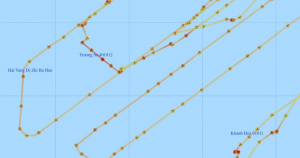
The path of China’s HYDZ- 8 and two of Vietnam’s ships from August 26 to 29, 2019. Vietnam’s ships sometimes cut across the path of the HYDZ-8. (Source: Marine Traffic/ South China Sea Chronicle Initiative)
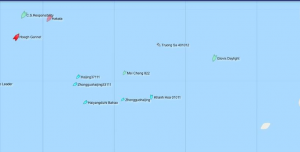
The HYDZ- 8 ship group’s array formation at 22:55 ‘on August 29, 2019. Three of China’s Coast Guard Ships, Haijing37111, Zhongguohaijing 33111, and Zhongguohaijing were guarding HYDZ-8 (Haiyangdizhi Bahao). Two of Vietnam’s ships, Khanh Hoa 01011 and Truong Sa 401012, were near the Chinese ships’ lineup. (Source: Marine Traffic/ South China Sea Chronicle Initiative)
During the second phase of the intrusion campaign, the survey vessel HYDZ-8 intruded deeper than ever into Vietnam’s exclusive economic zone approaching a location about 83.7 nautical miles from the coast. China’s Coast Guard ships also intruded into Vietnam’s EEZ approaching locations 82-95 nautical miles from the coast.
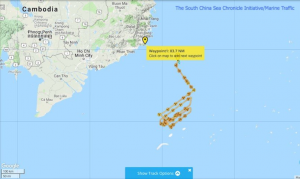
HYDZ-8 approached a location about 83.7 nautical miles off Vietnam’s coast at 5:08 before turning back. (Source: Marine Traffic/ South China Sea Chronicle Initiative)
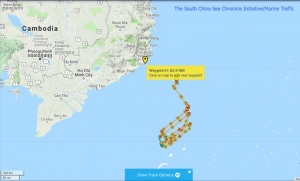
Simultaneously, China Coast Guard ship 37111 approached a location 82.9 nautical miles from Vietnam’s coast before turning back. (Source: Marine Traffic/ South China Sea Chronicle Initiative)

China Coast Guard ship 35111’s closest approach to Vietnam’s coastline (95 nautical miles) at 4:23 am, September 1, 2019. (Source: Marine Traffic/ South China Sea Chronicle Initiative)

China Coast Guard ship 46303’s closest approach to Vietnam’s coastline (91.6 nautical miles) at 4:33 am on September 1, 2019. (Source: Marine Traffic/ South China Sea Chronicle Initiative)
At the same time, north of the area where HYDZ-8 was surveying Vietnam’s continental shelf, China deployed crane vessel Lan Jing, a China National Offshore Oil Corporation ship. The vessel entered Vietnam’s territory sea just 11 nautical miles from the coast of Quang Ngai province. China’s purpose was to stretch the Vietnam Coast Guard from north to south along this area of intrusion.
In summary, China’s intrusion campaign in the summer of 2019 was a long-term campaign lasting more than three months, included well organized and mobilized civil and armed forces, simultaneously coordinated many forces and different intrusion directions as a Combined-Arms Campaign, and investigated the areas critical to Vietnam and Malaysia’s self-defense and exploitation of oil and gas.
Related article
China’s Campaign to intrude into the Continental Shelf and EEZs of Southeast Asian Countries in 2019 (Part 1: Process of the campaign, Part 2: Military tactics of the campaign, Part 3: Legal Aspects of the campaign)

 Politics & Economy3 years ago
Politics & Economy3 years ago
 Society & Culture4 years ago
Society & Culture4 years ago
 ARCHIVES4 years ago
ARCHIVES4 years ago
 Politics & Economy3 years ago
Politics & Economy3 years ago
 Politics & Economy4 years ago
Politics & Economy4 years ago
 Politics & Economy3 years ago
Politics & Economy3 years ago
 Politics & Economy4 years ago
Politics & Economy4 years ago
 ARCHIVES3 years ago
ARCHIVES3 years ago


